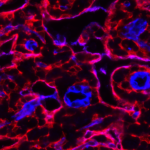Lien vers Pubmed [PMID] – 18270579
PLoS ONE 2008;3(2):e1592
BACKGROUND: Tamoxifen is still the most widely used drug in hormone therapy for the treatment of breast cancer. Its benefits in adjuvant treatment are well documented in controlled and randomized clinical studies, which have demonstrated an increase in disease-free intervals of patients with positive hormonal receptors. However, the mechanisms involved in endocrine resistance are not clear. Laboratory and clinical data now indicate that bi-directional molecular cross-talk between nuclear or membrane ER and growth factor receptor pathways may be involved in endocrine resistance. We recently found a functional interaction between alpha6beta4 integrin and ErbB-3 receptor to maintain the PI3K/Akt survival pathway of mammary tumour cells. We sought to improve understanding of this process in order to provide the involvement of both receptors insight into mechanism of Tamoxifen resistance.
METHODS AND FINDINGS: Using human breast cancer cell lines displaying different levels of alpha6beta4 and ErbB-3 receptors and a series of 232 breast cancer biopsies from patients submitted to adjuvant Tamoxifen monotherapy for five years, we evaluated the functional interaction between both receptors in relationship to Tamoxifen responsiveness. In mammary carcinoma cells, we evidenced that the alpha6beta4 integrin strongly influence Akt phosphorylation through ErbB-3 protein regulation. Moreover, the ErbB-3 inactivation inhibits Akt phosphorylation, induces apoptosis and inhibits in vitro invasion favouring Tamoxifen responsiveness. The analysis of human tumors revealed a significant relationship between alpha6beta4 and ErbB-3 in P-Akt-positive and ERbeta1-negative breast cancers derived from patients with lower disease free survival.
CONCLUSIONS: We provided evidence that a strong relationship occurs between alpha6beta4 and ErbB-3 positivity in ERbeta1-negative breast cancers. We also found that the association between ErbB-3 and P-Akt positivity mainly occurs in ERbeta1-negative breast cancer derived from patients with lower DFS indicating that both receptors are clinically relevant in predicting the response to Tamoxifen.

